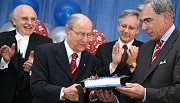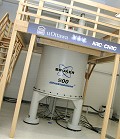| |
 |
| |
From left: Royal Galipeau, MP, Ottawa-Orléans; William G. Schneider, former president, NRC; Gilles Patry, president; and Pierre Coulombe, president, NRC. |
The Government of Canada in partnership with the University of Ottawa and the provinces of Quebec and Ontario officially opened the $15 million NRC W.G. Schneider Building on June 1, 2006. Named after nuclear magnetic resonance (NMR) pioneer and former NRC President, William G. Schneider, this unique building accommodates two NMR facilities - home to a critical mass of five spectrometers.
"These cutting edge facilities contribute to the Government of Canada's commitment to improve Canada's innovation performance and increase its ability to compete in the global marketplace," said Royal Galipeau, Member of Parliament for Ottawa-Orléans, who attended the event on behalf of the Honourable Maxime Bernier, Minister of Industry and Minister responsible for the NRC. "We feel it is important to foster scientific research in order to increase Canada's technological and industrial capacity".
The main attraction for Canadian scientists and industry is the multimillion dollar 900 MHz (21.1 Tesla) spectrometer, Canada's most powerful magnet. It will provide scientists with a new tool in their efforts to develop new battery composites, nano-materials for electronics, plastic polymers for vehicles, glasses for more sensitive sensors and faster computer processors, new materials for hydrogen storage, as well as health enhancing antibiotics.
"This new facility is a prime example of what can be achieved through collaboration," said NRC President Pierre Coulombe. "NRC believes that strategic partnerships like this one are key to building Canada's knowledge-based economy."
Since 1959, magnetic resonance has evolved and led to the development of medical imaging and diagnosing equipment - Magnetic Resonance Imaging commonly known as the MRI. The partners recognize the importance of researching quantum physics and chemistry through spectroscopic measures in order to build upon the strengths of innovative materials. This characterization of new materials and elements will improve our understanding and creation of aeronautical composites for the aerospace industry as well as more selective antimicrobial therapies for more economical air travel and healthier lives.
"The National Ultra-high Field NMR Facility for Solids is the first of its kind in the world and will promote international interest and collaboration, increasing Canada's scientific prestige on the global stage," said University of Ottawa President Gilles Patry. "Our institution is committed to promoting the exciting interdisciplinary work of our researchers through partnerships like this one and we look forward to the benefits this facility will offer the uOttawa community."
This uniquely nationwide networked centre was made possible thanks to the support of its public and private partners including Canada Foundation for Innovation (CFI) funding, a co-development agreement with Bruker Biospin and the collaborative staffing expertise and management from the University of Ottawa and NRC.
The Official Opening of the
NRC W.G. Schneider Building took place on June 1, 2006, also marking Mr. Schneider’s 91st birthday.
Related Link:
Nuclear magnetic resonance

